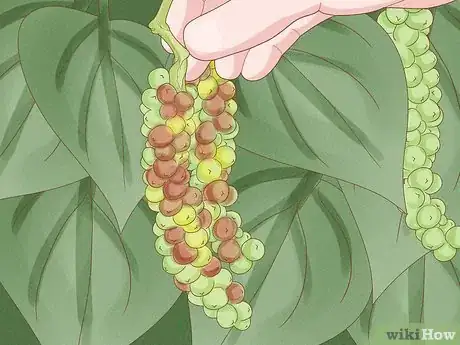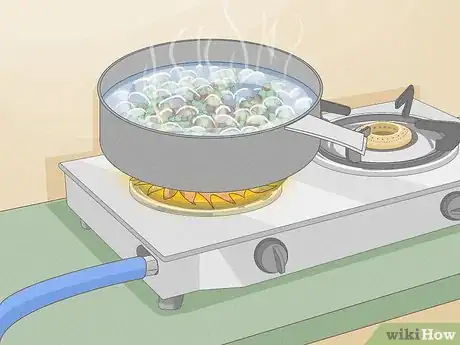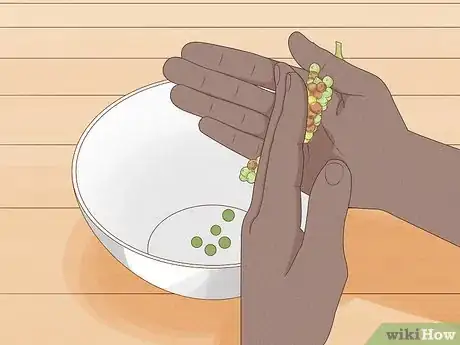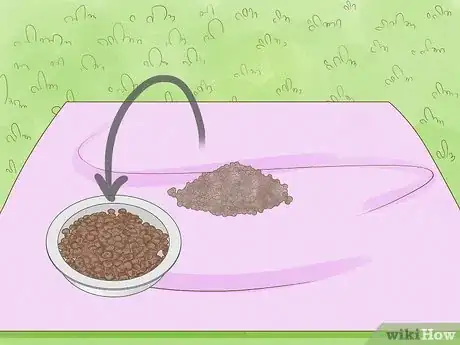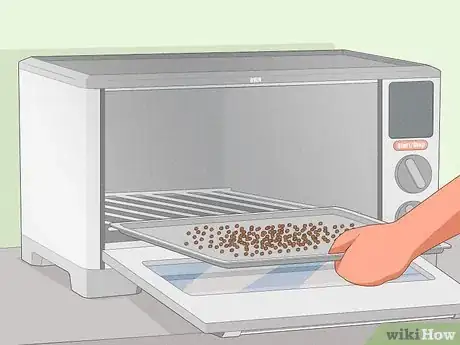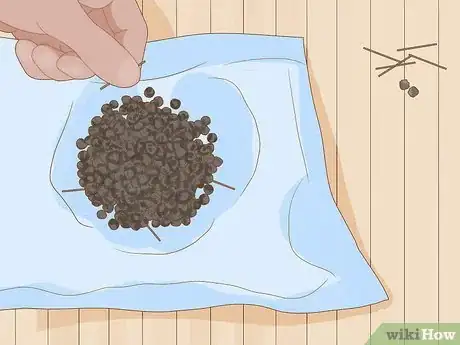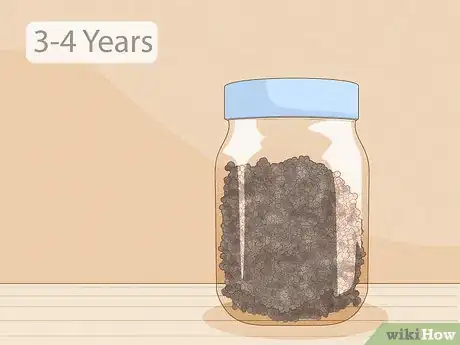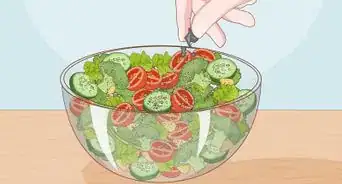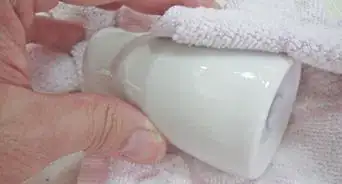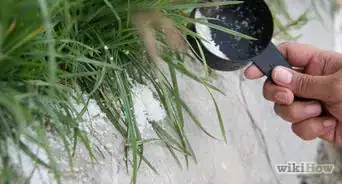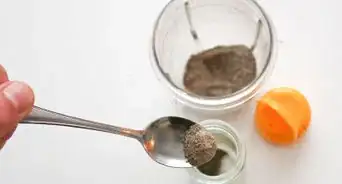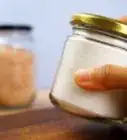This article was co-authored by wikiHow Staff. Our trained team of editors and researchers validate articles for accuracy and comprehensiveness. wikiHow's Content Management Team carefully monitors the work from our editorial staff to ensure that each article is backed by trusted research and meets our high quality standards.
There are 16 references cited in this article, which can be found at the bottom of the page.
This article has been viewed 19,216 times.
Learn more...
Drying the pepper berry into a peppercorn is the most important step in the production of black pepper. Doing it right leaves you with glossy, beautiful black peppercorns full of flavour, ready to show you why this spice a cornerstone of cooking. Like most good things, this takes labour and time, but it can be done without any expensive equipment.
Steps
How do you prepare fresh pepper for drying?
-
1Ferment the intact spikes in the sun to improve the scent. After harvesting, leave the spikes intact without removing any berries. Place the spikes out in the sun in a single layer. This initial 'fermentation' or 'first drying' is optional but recommended, as it helps breaks down some compounds in the plant to create a better black colour in the final peppercorn.[4]
- This step may vary the most between different growers in different parts of the world, when it is done at all; it can last anywhere from a few hours to a few days.[5] The details aren't important for a home project, but if you're growing to sell, you can try experimenting with different lengths to see how it affects the final result.
- If they're outside, they'll need constant supervision to prevent birds from eating the riper berries. If you're making a small batch at home, it's easier to place them next to a window.
-
2Blanch the berries in boiling water for 5-6 minutes to kill microbes. Put the pepper spikes inside a fine mesh sieve, or (for large batches) a clean, food-safe cloth bag on the end of a stick. Lower the container into boiling water and leave it for several minutes. Blanching improves the flavour, colour, and scent of the pepper and can help the berries dry more quickly.[6]
- If you're in a hurry, it's fine to blanch the berries in water as low as 60ºC (140ºF) for 30 seconds or so.[7]
-
3Knock the individual berries off the spikes. Let the spikes cool a bit after blanching them. Then, rub the spikes between your hands, trample them with your feet, or put them in containers and beat them with sticks.[8] This helps separate the berries from the broken stems and other plant parts.
- Wash your hands, feet (if you're trampling berries), and equipment thoroughly before separating the berries from the stems.
- For larger harvests, you can use automated threshing equipment to make the process easier.
How do you sun-dry pepper?
-
1Lay the berries on a clean, dry surface in direct sunlight. Keep the layer as thin as possible, with minimal overlap of berries. For large harvests, leave pathways between the berries so you can walk between them and reach them all with a rake.[9]
-
2Rake the berries every 3-4 hours to turn them over. This promotes even drying and helps prevent mould from developing on the berries. Supervise constantly to protect the berries against animals and rain.[10]
- Don't be too discouraged if some of the berries get wet, fouled by birds, or just go mouldy on their own. It's normal to lose a large percentage of the crop.[11] Just throw them away and focus on the rest.
-
3Gather the peppercorns after several days of drying them. Let the berries dry for at least 2-3 days in very hot, dry weather, or as many as 12 days in cool, humid weather.[12] A quick test used in Sri Lanka is to stop drying when you can put your hand into a pile of peppercorns and they stick to your hairs.[13]
How do you dry pepper in a drying machine or oven?
-
1Place the berries in a single layer inside the machine. Any forced-air dryer or convection dryer will work as long as it doesn't get too hot. You can even use an oven with a low-temperature "warm" setting, if you have a very small amount of pepper to dry.
-
2Dry the pepper at 55ºC (130ºF) until it reaches 12% water content. This temperature is recommended for best colour and flavour.[14] Higher temperatures work as long as the pepper never gets above 70ºC (160ºF).[15] The amount of time varies based on many factors, but this often takes less than a day.[16]
- Many drying machines don't stay at a constant temperature, so check often.
- If you are drying pepper for your own use, the exact water percentage doesn't matter. Just take out the pepper when they turn into black peppercorns.
- If you are growing pepper for sale or transport, measure the water content with chemistry equipment. You can use a Dean-Stark apparatus with toluene, or the Karl Fischer method (by hand or with an automated Karl Fischer titrator).[17]
How do you process black peppercorns for storage?
-
1Clean and sort the dried peppercorns. In a typical harvest, only about ⅓ of the green berries end up as usable black peppercorns.[18] Remove any stems or leaves that you see and toss out any peppercorns that are broken or the wrong size/colour. If you're selling the pepper, you could sell some of the defective ones separately to be turned into black pepper oil.[19]
- A sieve and/or a winnowing basket can help you remove dust and separate out different grades of pepper. Other types of sorting can be done by hand, but this is much easier with specialised machines. If you sell your pepper to a processing plant, these machines might be available there.
- The main factor in how many black peppercorns are usable is the cultivar of pepper. In Malaysia, for example, the cultivars "Semongok Emas," "Nyerigai," and "India" can have a yield over 40%.[20]
-
2Store whole peppercorns in clean, airtight containers for 3-4 years. Ideally, these should be brand-new, but you can reuse containers if you clean them thoroughly. Never reuse a container that has been used for non-food products, and keep the containers away from gardening products like pesticides.[21] Store the peppercorns in a cool, dark area and use them within 3-4 years.[22]
- An airtight material such as glass or plastic is best to prevent the loss of flavour and excessive drying. If using polypropylene plastic, seal the edges with heat to make them airtight. Avoid polythene, which does not stop flavour loss.[23]
- If using jute bags or other cloth bags, do not label them with ink, since it can seep through the bag. A paper tag is better.[24]
- If you are processing a large amount of black pepper for sale, store it in its own room away from other foods.[25]
Warnings
- Always transport black pepper in cool, dry, well-ventilated vehicles. Protect the containers from moisture with absorbent cloths, mats, and/or anti-condensation films and paints. Black pepper also releases its own water into the air, so do not ship it with other moisture-sensitive products.[28]⧼thumbs_response⧽
References
- ↑ http://www.micronesialandgrant.org/wp-content/uploads/2018/03/COMFSM-Black-Pepper-Cultivation-Guide-Verma-2018-Updated-03022018.pdf
- ↑ https://www.researchgate.net/publication/342621161_Botany_Diversity_and_Distribution_of_Black_Pepper_Piper_nigrum_L_Cultivars_in_Malaysia
- ↑ https://www.researchgate.net/profile/Giridhar-Raghavan-Nair/publication/227220417_Fermentative_production_of_white_pepper_using_indigenous_bacterial_isolates/links/02bfe50ebd98beb655000000/Fermentative-production-of-white-pepper-using-indigenous-bacterial-isolates.pdf
- ↑ http://www.nzdl.org/cgi-bin/library?e=d-00000-00---off-0fnl2.2--00-0----0-10-0---0---0direct-10---4-------0-1l--11-en-50---20-about---00-0-1-00-0--4----0-0-11-10-0utfZz-8-00&cl=CL3.38&d=HASHfb1b5c4e694a7fcda1ec78.5
- ↑ http://www.nzdl.org/cgi-bin/library?e=d-00000-00---off-0fnl2.2--00-0----0-10-0---0---0direct-10---4-------0-1l--11-en-50---20-about---00-0-1-00-0--4----0-0-11-10-0utfZz-8-00&cl=CL3.38&d=HASHfb1b5c4e694a7fcda1ec78.5
- ↑ http://www.iserd.net/wordpress/wp-content/uploads/2018/04/IJERD-Vol8-2_for_Proof-reading.pdf
- ↑ https://umr-qualisud.cirad.fr/en/content/download/4886/36329/version/1/file/ACL+Impact+of+blanching%2C+sweating+and+drying+operations+2017.pdf
- ↑ https://www.indiaagronet.com/horticulture/CONTENTS/black_pepper.htm
- ↑ http://www.fao.org/input/download/standards/27/CXP_042e_2014.pdf
- ↑ http://www.nzdl.org/cgi-bin/library?e=d-00000-00---off-0fnl2.2--00-0----0-10-0---0---0direct-10---4-------0-1l--11-en-50---20-about---00-0-1-00-0--4----0-0-11-10-0utfZz-8-00&cl=CL3.38&d=HASHfb1b5c4e694a7fcda1ec78.5
- ↑ https://doa.sarawak.gov.my/modules/web/download_show.php?id=578
- ↑ http://psasir.upm.edu.my/id/eprint/3381/1/Drying_of_Black_Pepper_(Piper_nigrum_L.)_Using_Solar_Tunnel_Dryer.pdf
- ↑ http://www.nzdl.org/cgi-bin/library?e=d-00000-00---off-0fnl2.2--00-0----0-10-0---0---0direct-10---4-------0-1l--11-en-50---20-about---00-0-1-00-0--4----0-0-11-10-0utfZz-8-00&cl=CL3.38&d=HASHfb1b5c4e694a7fcda1ec78.5
- ↑ https://pubmed.ncbi.nlm.nih.gov/33114432/
- ↑ http://psasir.upm.edu.my/id/eprint/3381/1/Drying_of_Black_Pepper_(Piper_nigrum_L.)_Using_Solar_Tunnel_Dryer.pdf
- ↑ http://www.fao.org/input/download/standards/27/CXP_042e_2014.pdf
- ↑ https://old.fssai.gov.in/Portals/0/Pdf/Draft_Manuals/SPICES_AND_CONDIMENTS.pdf
- ↑ https://doa.sarawak.gov.my/modules/web/download_show.php?id=578
- ↑ http://www.fao.org/3/au145e/au145e.pdf
- ↑ https://www.researchgate.net/publication/342621161_Botany_Diversity_and_Distribution_of_Black_Pepper_Piper_nigrum_L_Cultivars_in_Malaysia
- ↑ https://doa.sarawak.gov.my/modules/web/download_show.php?id=578
- ↑ https://www.stilltasty.com/Fooditems/index/16547
- ↑ https://doa.sarawak.gov.my/modules/web/download_show.php?id=578
- ↑ http://www.fao.org/input/download/standards/27/CXP_042e_2014.pdf
- ↑ https://doa.sarawak.gov.my/modules/web/download_show.php?id=578
- ↑ https://www.tis-gdv.de/tis_e/ware/gewuerze/pfeffer/pfeffer-htm/#feuchte
- ↑ http://www.fao.org/3/au145e/au145e.pdf
- ↑ https://www.tis-gdv.de/tis_e/ware/gewuerze/pfeffer/pfeffer-htm/
